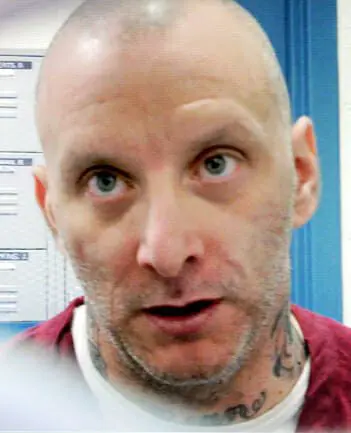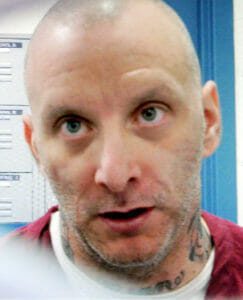Robert Gleason was the last person to be executed by the State of Virginia after he was sentenced to death after two prison murders. According to court documents Robert Gleason was initially sentenced to life in prison for a murder. However once behind bars he would not stop killing. Robert Gleason would murder his first cellmate in 2009. Robert Gleason would be transferred to a super max prison known as Red Onion where he would again murder another prisoner. Robert Gleason would be sentenced to death for the two murders. Gleason demanded that he would be executed and he wanted to be executed by the electric chair. On January 16, 2013 Robert Gleason would get his wish and would be executed in the electric chair.
Robert Gleason More News
Robert C. Gleason Jr. died with fists partially clenched and smoke rising from his body.
He was faceless Wednesday night, the throes of death hidden behind a thick, black mask that allowed enough space only for his nose to poke through.
Death came on his own terms: He sought execution for a pair of murders in two Southwest Virginia prisons and asked for the electric chair.
There was the customary, last-minute flurry of appeals rejected by the governor and the U.S. Supreme Court. But those weren’t his appeals. Instead, they were filed by a team of capital defense attorneys arguing Gleason’s mental incompetence and hoping for the chance to represent him.
And Gleason, like the governor and federal judges, rejected their help to the very end.
His last words in the execution chamber at the Greensville Correctional Center in Jarratt, Va., were cryptic.
“Well, I hope Percy ain’t going to wet the sponge. Put me on the highway to Jackson and call my Irish buddies. Pog mo thoin. God bless,” he said.
The translation of the Irish Gaelic wording is “kiss my a–.”
Death took roughly eight minutes from the time the condemned man entered the chamber.
The execution, taking place on the other side of a two-way window, was like a play that began with Gleason taking a few steps into a cinderblock room and ended with someone mumbling a “time of death.”
It culminated with someone drawing a blue curtain across the witness room window and a prison official telling the witnesses it was time to leave.
Robert Gleason died violently as more than 1,000 volts of electricity jolted his body in a pair of 90-second cycles.
He smiled to the room full of witnesses as soon as he stepped into the execution chamber and winked at his spiritual advisor, who was sitting in the crowd. He gave a thumbs up as he sat in the chair.
Robert Gleason wore flip-flops, a blue shirt and dark blue pants with the right pant leg cut off at the knee. A skullcap was placed on his head and a brine-soaked sea sponge was strapped to his right tattoo-covered calf.
A pair of cables snaked up along the electric chair to the top of the skullcap and along the ground onto the floor to his calves.
A guard stood with a red phone in his hand that was a direct line to the governor’s office. But there would be no intervention.
At 9 p.m., a man with the phone nodded for the executioner to begin. One man turned a key in a wall to activate the system and another man in an adjacent room started the electrocution.
Gleason’s body spasmed with each series of jolts, smoke rising from the mask.
The jolts were administered at 9:03, and after five long minutes of silence a doctor in a white coat entered from a side room, put a stethoscope to his tattooed chest and then nodded that he was dead.
He then pronounced the time of death as 9:08 p.m.
Sitting in another room to view the execution was Kim Strickland, the mother of the last victim, Aaron Alexander Cooper.
“May God have mercy on his soul,” she said Monday of her son’s killer. “I have been and will be praying for his family throughout this ordeal.”
In a letter sent to her, Robert Gleason described Cooper’s death and noted that he was holding on to the mother’s address.
“Everyone will be O.K. if I get the death penalty,” he wrote.
Strickland, fearing his reach beyond prison walls, has moved several times since her son died and remains on the run.
“A very reliable source told me I was not safe and I have moved four or five times,” she testified during a 2011 sentencing hearing. “I have no sense of home anymore.”
Now penniless, she lives out of her car and shelters.
Amy Taylor, the mother of one of Gleason’s children, said she will miss him.
“He will always be remembered by those who truly knew him as a very fun, loving, compassionate person who cared more for those he loved than he ever did for himself,” she said.
Robert Gleason spent his last two hours with his spiritual advisor, Tim “Bam Bam” Spradling, a former biker buddy who now preaches at a Richmond church.
“We talked about how my life went one way and his went in the opposite direction,” Spradling said.
In those last hours, Robert Gleason cried for his victims and asked God for forgiveness, he added.
No one seems to know the real reason Gleason demanded execution. In court, he said it was to teach younger relatives that murder comes with severe consequences.
Yet, a case worker’s report from 2011 suggests that Gleason had a mental history filled with feelings of paranoia, anxiety and depression, ultimately leading to exhaustion and a need to escape. Life in prison, according to the report, would simply be too intolerable.
Initially, Gleason earned life in prison without parole for shooting to death truck driver Michael Kent Jamerson on May 8, 2007, to cover up the tracks of a methamphetamine ring already eyed by federal investigators.
Robert Gleason, during his 2011 sentencing hearing, said they had stopped by a wooded area in Amherst County and he pulled a pistol from Jamerson’s own belt, told him to get right with God, and began shooting.
A turkey hunter found Jamerson’s body the next day. A Liberty University student fishing along the bank of the James River, about three miles from the body, found the gun several days later.
Two years later, Gleason ended up in a cell with 63-year-old Harvey Gray Watson Jr. at Wallens Ridge State Prison in Big Stone Gap. Watson was serving a 100-year sentence for killing a man and wounding two others when he fired a shotgun into his neighbor’s Lynchburg home in 1983.
The older inmate was mentally impaired and known for such antics as singing nonsensical tunes throughout the night and drinking his own urine. Gleason tired of him after about a week and tied him up, beat and strangled him on May 8, 2009 – the two-year anniversary of Jamerson’s murder.
Guards didn’t notice the body in the cell for 15 hours.
Soon after that, Gleason threatened to kill again unless given the death penalty.
Then, on July 28, 2010, he strangled convicted carjacker Aaron Alexander Cooper, 26, in the recreation yard of the supermax security Red Onion State Prison near Pound.
It was done with ripped apart strips of braided bed sheet threaded through the chain link fence separating the two inmates.
https://heraldcourier.com/news/robert-gleason-got-death-the-way-he-wanted-it/article_539a0bea-602d-11e2-9e30-001a4bcf6878.html









